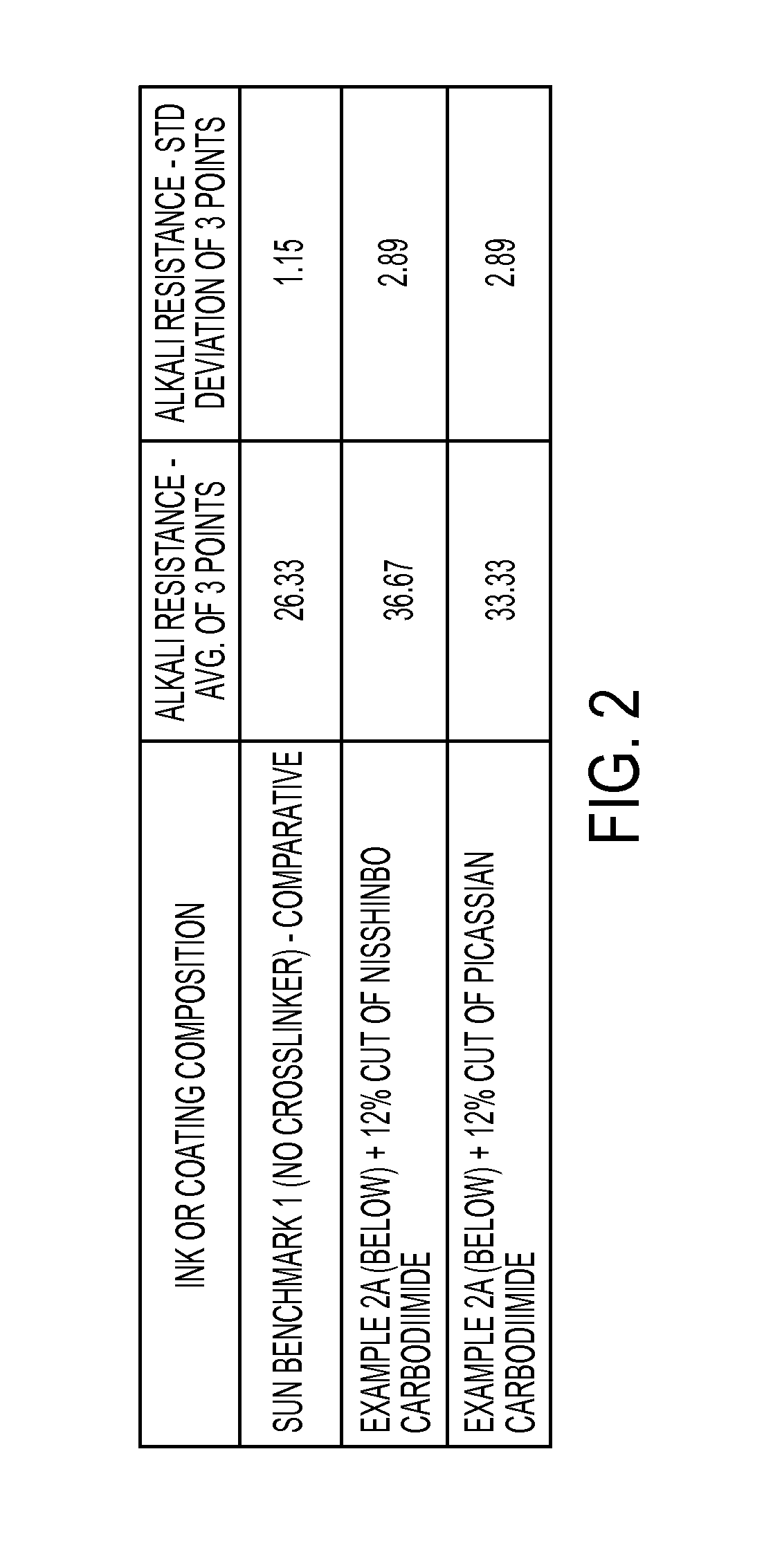Substrate Printed with a Water-Based Urethane Printing Ink with Improved Performance Properties
a technology of water-based urethane and printing ink, which is applied in the field of printing substrates with water-based urethane printing ink with improved performance properties, can solve the problems that the particular block urethane used may not be acceptable for garment applications (human contact), and achieves improved dry, saline and oil crockfastness, the effect of prolonging the life of convenience products and desirable color strength
- Summary
- Abstract
- Description
- Claims
- Application Information
AI Technical Summary
Benefits of technology
Problems solved by technology
Method used
Image
Examples
example 1
Alkali Resistance
[0115]The substrate test specimen used in this and all examples, except Example 4, was a polypropylene nonwoven laminated on a polyethylene sheet of typical basis weight, for example, about 50 g / square meter, suitable for diaper backsheet or other hygiene product and useable in other convenience articles of manufacture. In particular, the test specimen comprised a non-woven laminate having a nonwoven side, on which side a composition is deposited, consisting of polypropylene fibers laminated to a polyethylene sheet. Such a nonwoven substrate being within the generic category of a polyolefin is known to be of low surface energy and consequently poor wetting and adhesion of ink and coating compositions. Such a non-woven substrate would then exhibit a worst case scenario when considered with other categories of non-woven substrates including those mentioned above including but not limited to polyamides, polyesters, polylactic acid (PLA) and its derivatives, copolymers ...
example 2
Finished Ink or Coating Compositions
[0119]Example 2 demonstrates the final performance of a fully formulated ink or coating composition based on a suitable aliphatic polyester polyurethane dispersion (PUD) and epoxy ester pigment dispersions for each color. Table 1A provides finished composition formulas used in printing substrates and articles of manufacture as discussed above by the method discussed above. Table 1B summarizes dry and “wet” (baby oil, and saline) crockfastness results for Examples 2A-2D versus the Sun Benchmark 1 inks with no crosslinking agent. The following formulations for Example 2A (red), 2B (blue), 2C (black), and 2D (yellow) received a cut with water of between about 0 and 10wt % and preferably about 2-5% by weight (that is, about 2-5 grams of water were added to 100 grams of composition) to bring the viscosity to about 22″±2 number 2 EZ cup.
[0120]Referring to FIG. 3, the compositions in depicted Table 1A were tested for crockfastness using the test methods ...
example 4
Abrasion Resistance of a Polyolefin Film Suitable for Use as a Backsheet of a Hygiene Product
[0125]The following example demonstrates the final oil and saline rub performance of the fully formulated ink or coating composition as described in Example 2 crosslinked with SV02 on a breathable polyolefin (polyethylene) film of a thickness of about 22 microns that is suitable for use, for example, in a backsheet of a hygiene product generally described herein as a polymeric film. The substrate “as received” was marked “treated.” A thicker polymeric film may be used, for example, as a geotextile in the manufacture of landscaping and construction bags, tarps and the like. Again, a polyolefin class of films may be considered a worst case scenario as representative of categories of film substrates that may be printed or coated and comprise articles of manufacture described herein for testing for crockfast values.
[0126]The example compositions were formulated as in Example 2 and received about...
PUM
| Property | Measurement | Unit |
|---|---|---|
| wt % | aaaaa | aaaaa |
| wt % | aaaaa | aaaaa |
| wt % | aaaaa | aaaaa |
Abstract
Description
Claims
Application Information
 Login to View More
Login to View More - R&D
- Intellectual Property
- Life Sciences
- Materials
- Tech Scout
- Unparalleled Data Quality
- Higher Quality Content
- 60% Fewer Hallucinations
Browse by: Latest US Patents, China's latest patents, Technical Efficacy Thesaurus, Application Domain, Technology Topic, Popular Technical Reports.
© 2025 PatSnap. All rights reserved.Legal|Privacy policy|Modern Slavery Act Transparency Statement|Sitemap|About US| Contact US: help@patsnap.com



